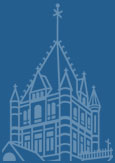
- Trinity Voices
Inside The Yellow House
Dear friends,
Here’s a question for you: what does it mean to be “a people” when the only home you have known together – the structure that has convened and sheltered – is closed or no more? I thought about that when visiting the Western Wall in Jerusalem a few years ago as part of a Trinity pilgrimage. While our current exile from Copley Square is temporary, a kindred and nonetheless painful absence is at the heart of our common life right now. “Houses provide a frame that bears us up,” writes Sarah M. Broom in her memoir The Yellow House (p. 232). Who are we without them? For the Webb/Broom family we meet in these pages, the answer is not unlike that of the Jews after the destruction of the Second Temple in 70 CE: “When the house fell down,” Broom realizes, “something in me opened up…We are the house that bears itself up” (Ibid).
The Yellow House, which we are reading and discussing together in the next three weeks, has at its center what Broom and her New Orleans community call “The Water”: Hurricane Katrina and its catastrophic aftermath (particularly for Black people) exactly fifteen years ago this month. I don’t shelve it mentally with other memoirs, though, because in telling her own story Broom illuminates so much else: the rapacious development that created and then abandoned her neighborhood, New Orleans East; her “braided and contradictory” (p. 320) feelings about her native city and its tourist-focused mythologies which marginalize so many, primarily people who are not white; the manner in which “official history” showcases some and erases others. I can’t name a recent writer who manages appealing reticence while presenting a self so deeply attached, nerve and capillary, to so much beyond that self: her mother and eleven siblings, her city and its charms, horrors, inefficiencies and systemic injustices.
In seminary I was taught that one of the biggest hurdles we encounter when reading scripture as 21st-century people is that we absorb it all so personally. A passage such as the Beatitudes, for example, withers to wisdom addressed to the hearer alone, to a private benchmark instead of guidance for common life in community.
Scripture was a written, though, (and Jesus most often speaks) to communities. And it is Brooms’ generous voice, the lack of a “rind” between her own story and the stories of her family, neighborhood and city – that make The Yellow House a kind of scripture for the moment we are in as a church and as a nation. A “frame” for the next several weeks as we begin a new program year together. We hope you can join us in The Yellow House.
A few details:
- Grove Press has provided a link here so that we may purchase The Yellow House (just out in paperback) from independent booksellers.
- Join us on three coming Sunday evenings (September 13, 20, and 27) via ZOOM for parish-wide conversation about The Yellow House. See our schedule, with Zoom links, in the September 10th “This Week at Trinity” e-blast. Sarah Broom herself will join us on September 20 to read, offer some additional insight, and answer questions. If you have a question you’d like to ask, direct that to me in writing by emailing me at pward@trinitychurchboston.org.
- Finally, join a small group to explore The Yellow House in community! We will host numerous sessions from September 14-19. While many are already in process by ministry team, we also have a number of open groups and groups organized by topic. Learn more and sign up here. Find questions to help start your conversations at the bottom of that same page.
We’re looking forward to being with you in these coming weeks. See you in church!
Patrick
- December 2022
- November 2022
- June 2022
- February 2022
- January 2022
- October 2021
- September 2021
- August 2021
- July 2021
- June 2021
- May 2021
- April 2021
- March 2021
- February 2021
- January 2021
- December 2020
- November 2020
- October 2020
- September 2020
- August 2020
- July 2020
- June 2020
- May 2020
- April 2020
- March 2020


Comments